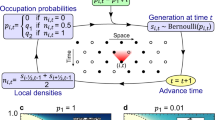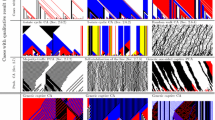Abstract
We show that under the Bernoulli initial condition two kinks in the cellular automaton (CA) 18/256 will annihilate each other with probability one. It turns out that there is an equivalent statement in terms of percolation in the simple binary additive CA. Namely, under the Bernoulli initial condition, l's do not percolate in the binary additive CA.
Similar content being viewed by others
References
K. Eloranta and E. Nummelin, The kink of cellular automaton rule 18 performs a random walk,J. Stat. Phys. 69:1131–1136 (1962).
P. Grassberger, Chaos and diffusion in deterministic cellular automata,Physica D 10:52–58 (1984).
E. Jen, Aperiodicity in one-dimensional cellular automata,Physica D 46:3–18 (1990).
D. A. Lind, Applications of ergodic theory and sofic systems to cellular automata,Physica D 10:36–44 (1984).
S. Wolfram,Theory and Applications of Cellular Automata (World Scientific, Singapore, 1986).
Author information
Authors and Affiliations
Rights and permissions
About this article
Cite this article
Nummelin, E. Kink movements and percolation in the binary additive cellular automaton. J Stat Phys 75, 879–889 (1994). https://doi.org/10.1007/BF02186748
Received:
Issue Date:
DOI: https://doi.org/10.1007/BF02186748




